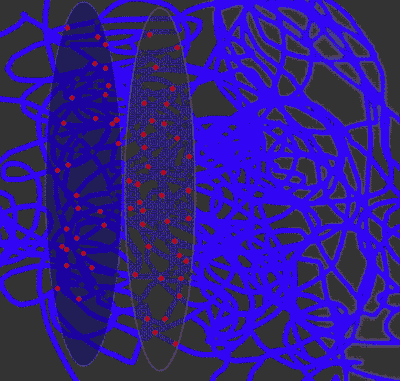Lines which are flung onto the canvas have an all-at-once-ness about them: they issue from a wave, a gesture, rather than from the point of a pencil. Time here is seen not as a drawn-out linear sequence of discrete events but as an all-encompassing landscape of possible paths: a hybrid dimension known to the physicists as space-time . In Pollock's Blue Poles ... the distinction between north, south, east, west becomes blurred. The ‘poles’, viewed as ‘polarities’, become transposable, ambiguous, mobile. Even his method of working around the four sides of the canvas, laid out on the floor as ground, meant that top, bottom, left and right were interchangeable. It also meant that he could be in the painting, and this also reflected contemporary research in psychology and quantum mechanics, namely, that subject and object are inseparable; that observer is part of the observed 'reality' , and part of the process we call ‘observation’; that therefore we cannot speak of 'realities' independent of consciousness or interpretation.
Meanwhile, physicists were painting their own kind of Blue Poles, a physical and mathematical higher-dimensional synthesis of matter and time which viewed particles as paths through space-time. One of the most beautiful of these pictures was surely that created through the genius of Prof. John Wheeler and Richard Feynman (Nobel laureate in physics). They had been exploring time symmetries of past and future at the quantum level. One day, in a Eureka moment, Wheeler had rung Feynman to say he knew why all electrons had exactly the same mass and charge, ‘Because they are the same electron!’ (J. Gleick, 1993, p. 122.)
Picture a point or particle tracing out a line in space-time that stretches from past to future. Minkowski coined the term, world-line to describe such a line; ‘ . . . the everlasting career of a substantial point . . . ’ (J. Gleick, 1993, p. 122) the whole universe filled with similar such lines or 'histories'. Wheeler imagined the electron as a tremendous knot in four-dimensional space-time .

When we look at the universe from a particular point in time and space, it is tantamount to slicing through this ‘knot’. We are not seeing its past and future as a seamless entity. Rather we are seeing it in cross-section; the plane corresponding to a point in time which we call ‘ now’. This single-electron Wheeler imagined as an incredibly knotted thread running through space-time. When we look at it, we can only perceive a lower-dimensional ‘cross-section’ and thus this incredibly convoluted higher-dimensional electron-positron-unity is ‘divided’ by our ‘viewing-at-an-instant’ (in tune with the quantum idea that an observer’s viewing is active rather than passive) and what we perceive is billions upon billions of 'particles' or 'points'. So Wheeler ingeniously was able to see that these innumerable electrons (of identical mass and charge) could in fact be part of a higher-dimensional unity: ‘ There is only one electron ’(J. Gleick, 1993, p. 122). The illusion is of many particles. The reality is of one line, one path. But he also intuited that when the line passed through this plane in the opposite direction, it was the antiparticle of the electron, or time-reversed positron, coming back from the future.
The philosophical, psychological and cultural implications of such a seemingly quaint idea are staggering. Imagine for a moment that we are all, in a very real sense, connected in space-time ; that our separateness is a three-dimensional illusion!
Here again is echoed the concept of the unit , reflected in so many of the major breakthroughs in science and the humanities—how apparently diverse and unrelated objects and events are in fact unified and interdependent. We must endeavour to discover the connections that unite the disparate. In so doing, we will draw closer to resonant scale structures . As we draw closer, the magnetism of these 'attractors' will get us there very quickly indeed, allowing us to find even higher-level connections. It is likely that these advances may parallel profound extensions to human thinking and consciousness and, this in turn, will resonate and impact upon every area of culture and society.(W. Roberts, 2003, pp. 62, 66-68.) |
 |
